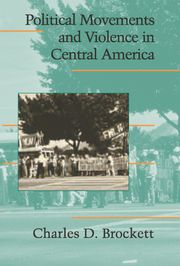Book contents
- Frontmatter
- Contents
- Figures, Tables, and Maps
- Abbreviations and Acronyms
- Acknowledgments
- 1 INTRODUCTION
- Part One From Grievances to Contentious Movements
- Part Two Opportunity, Contention, and Repression
- 6 CYCLES OF CONTENTION
- 7 CHANGING POLITICAL OPPORTUNITIES AND CONTENTIOUS CHALLENGERS: GUATEMALA
- 8 CHANGING POLITICAL OPPORTUNITIES AND CONTENTIOUS CHALLENGERS: EL SALVADOR AND CENTRAL AMERICA
- 9 CONTENTION AND REPRESSION: GUATEMALA
- 10 CONTENTION AND REPRESSION: EL SALVADOR
- 11 CONCLUSION
- References
- Index
9 - CONTENTION AND REPRESSION: GUATEMALA
Published online by Cambridge University Press: 23 November 2009
- Frontmatter
- Contents
- Figures, Tables, and Maps
- Abbreviations and Acronyms
- Acknowledgments
- 1 INTRODUCTION
- Part One From Grievances to Contentious Movements
- Part Two Opportunity, Contention, and Repression
- 6 CYCLES OF CONTENTION
- 7 CHANGING POLITICAL OPPORTUNITIES AND CONTENTIOUS CHALLENGERS: GUATEMALA
- 8 CHANGING POLITICAL OPPORTUNITIES AND CONTENTIOUS CHALLENGERS: EL SALVADOR AND CENTRAL AMERICA
- 9 CONTENTION AND REPRESSION: GUATEMALA
- 10 CONTENTION AND REPRESSION: EL SALVADOR
- 11 CONCLUSION
- References
- Index
Summary
It should be well established by the prior chapters that the relationship between popular contention and government repression is crucial for understanding both El Salvador and Guatemala in recent decades. More generally, this relationship is an especially intriguing one theoretically for social scientists because after decades of good work by many scholars the fundamental puzzle remains. Following his thorough review of the existing literature more than two decades ago, Zimmerman identified “theoretical arguments for all conceivable basic relations between governmental coercion and group protest and rebellion except for no relationship” (Zimmerman 1980, 181). Seven years later the dilemma remained, well-captured in the title of Lichbach's (1987) oft-cited theoretical analysis: “Deterrence or Escalation? The Puzzle of Aggregate Studies of Repression and Dissent.” Judging by the most recent reviews of the literature, such as Davenport 2000; Goldstone 2001; and Goldstone and Tilly 2001, the puzzle persists.
Clearly repression often succeeds for the state, deterring popular protest, for reasons thoroughly elaborated in the scholarly literature. At other times repression provokes heightened popular mobilization, including sometimes increased support for, and participation in, revolutionary movements. Again, probable reasons for this opposite effect are amply explored in the literature. Accordingly, the real task before us has been, as Opp and Roehl (1990, 523) point out, to determine “which effect is to be expected under what conditions.”
Bringing some resolution to the puzzle of the paradoxical relationship between repression and protest is the principle task of this and the next chapter.
- Type
- Chapter
- Information
- Political Movements and Violence in Central America , pp. 265 - 291Publisher: Cambridge University PressPrint publication year: 2005

